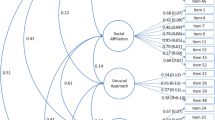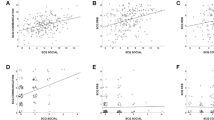Abstract
The present study examines co-occurring psychiatric syndromes in a well-characterized sample of youths with autism spectrum disorders (ASD; n = 177) and their siblings (n = 148), reported independently by parents and teachers. In ASD, parents reported substantial comorbidity with affective (26%), anxiety (25%), attentional (25%), conduct (16%), oppositional (15%), and somatic problems (6%). Teachers reported a much lower prevalence. Autistic severity scores for children with ASD exhibited moderate correlations with general psychopathology within- but not across-informants, whereas, sibling correlations were significant both within- and across-informants. Results support the role of environmental context in psychiatric symptom expression in children affected by autism and suggest that informant discrepancies may more provide critical cues for these children via specific environmental modifications.

Similar content being viewed by others
References
Achenbach, T. M. (1991a). Manual for teacher’s report form and 1991 profile. Burlington, VT: University of Vermont, Department of Psychiatry.
Achenbach, T. M. (1991b). Manual for the child behavioral checklist/4–18 and 1991 profile. Burlington, VT: University of Vermont, Department of Psychiatry.
Achenbach, T. M. (1991c). Manual for the youth self-report and 1991 profile. Burlington, VT: University of Vermont, Department of Psychiatry.
Achenbach, T. M., & Edelbrock, C. (1983). Manual for the child behavioral checklist and revised child behavioral profile. Burlington, VT: University of Vermont, Department of Psychiatry.
Achenbach, T. M., & Rescorla, L. A. (2001a). Manual for the ASEBA preschool forms & profiles. Burlington, VT: University of Vermont, Research Center for Children, Youth, & Families.
Achenbach, T. M., & Rescorla, L. A. (2001b). Manual for the ASEBA school-age forms & profiles. Burlington, VT: University of Vermont, Research Center for Children, Youth, & Families.
Bishop, D. V. M. (1998). Development of the children’s communication checklist (CCC): A method for assessing qualitative aspects of communicative impairment in children. Journal of Child Psychology and Psychiatry and Allied Disciplines, 39(6), 879–891. doi:10.1017/S0021963098002832.
Constantino, J. N., & Todd, R. D. (2000). Genetic structure of reciprocal social behavior. The American Journal of Psychiatry, 157(12), 2043–2044. doi:10.1176/appi.ajp.157.12.2043.
Constantino, J. N., & Todd, R. D. (2003). Autistic traits in the general population: A twin study. Archives of General Psychiatry, 60(5), 524–530. doi:10.1001/archpsyc.60.5.524.
Constantino, J. N., & Todd, R. D. (2008) Genetic epidemiology of pervasive developmental disorders. In: J. J. Hudziak (Ed.), Developmental psychopathology and wellness: Genetic and environmental influences (pp. 209-224).
Constantino, J. N., Przybeck, T., Friesen, D., & Todd, R. D. (2000). Reciprocal social behavior in children with and without pervasive developmental disorders. Journal of Developmental and Behavioral Pediatrics, 21(1), 2–11. doi:10.1097/00004703-200002000-00001.
Constantino, J. N., Davis, S. A., Todd, R. D., Schindler, M. K., Gross, M. M., Brophy, S. L., et al. (2003). Validation of a brief quantitative measure of autistic traits: Comparison of the social responsiveness scale with the autism diagnostic interview-revised. Journal of Autism and Developmental Disorders, 33(4), 427–433. doi:10.1023/A:1025014929212.
Constantino, J. N., LaVesser, P. D., Zhang, Y., Abbacchi, A. M., Gray, T., & Todd, R. D. (2007). Rapid quantitative assessment of autistic social impairment by classroom teachers. Journal of the American Academy of Child and Adolescent Psychiatry, 46(12), 1668–1676.
Constantino, J. N., Abbacchi, A. M., LaVesser, P. D., Reed, H., Givens, L., Chiang, L., et al. (2009). Developmental course of autistic social impairment in males. Development and Psychopathology, 2, 127–138.
de Bruin, E. I., Ferdinand, R. F., Meester, S., de Nijs, P. F. A., & Verheij, F. (2007). High rates of psychiatric co-morbidity in PDD-NOS. Journal of Autism and Developmental Disorders, 37(5), 877–886. doi:10.1007/s10803-006-0215-x.
De Los Reyes, A., & Kazdin, A. E. (2005). Informant discrepancies in the assessment of childhood psychopathology: A critical review, theoretical framework, and recommendations for further study. Psychological Bulletin, 131(4), 483–509. doi:10.1037/0033-2909.131.4.483.
Duarte, C. S., Bordin, I. A. S., de Oliveira, A., & Bird, H. (2003). The CBCL and the identification of children with autism and related conditions in Brazil: Pilot findings. Journal of Autism and Developmental Disorders, 33(6), 703–707. doi:10.1023/B:JADD.0000006005.31818.1c.
Filipek, P. A., Accardo, P. J., Ashwal, S., Baranek, G. T., Cook, E. H., Jr, Dawson, G., et al. (2000). Practice parameter: Screening and diagnosis of autism: Report of the quality standards subcommittee of the American academy of neurology and the child neurology society. Neurology, 55(4), 468–479.
Gadow, K. D., DeVincent, C. J., Pomeroy, J., & Azizian, A. (2004). Psychiatric symptoms in preschool children with PDD and clinic and comparison samples. Journal of Autism and Developmental Disorders, 34(4), 379–393. doi:10.1023/B:JADD.0000037415.21458.93.
Gadow, K. D., Devincent, C. J., Pomeroy, J., & Azizian, A. (2005). Comparison of DSM-IV symptoms in elementary school-age children with PDD versus clinic and community samples. Autism, 9(4), 392–415. doi:10.1177/1362361305056079.
Gadow, K. D., DeVincent, C. J., & Pomeroy, J. (2006). ADHD symptom subtypes in children with pervasive developmental disorder. Journal of Autism and Developmental Disorders, 36(2), 271–283. doi:10.1007/s10803-005-0060-3.
Ghaziuddin, M., Weidmer-Mikhail, E., & Ghaziuddin, N. (1998). Comorbidity of asperger syndrome: A preliminary report. Journal of Intellectual Disability Research, 42(4), 279–283.
Ghaziuddin, M., Ghaziuddin, N., & Greden, J. (2002). Depression in persons with autism: Implications for research and clinical care. Journal of Autism and Developmental Disorders, 32(4), 299–306. doi:10.1023/A:1016330802348.
Gioia, G. A., Isquith, P. K., Guy, S. C., & Kenworthy, L. (2000). Behavior rating inventory of executive function. Child Neuropsychology, 6(3), 235–238. doi:10.1076/chin.6.3.235.3152.
Howlin, P. (2000). Outcome in adult life for more able individuals with autism or asperger syndrome. Autism, 4(1), 63–83. doi:10.1177/1362361300004001005.
Hoyt, W. T. (2000). Rater bias in psychological research: When is it a problem and what can we do about it? Psychological Methods, 5(1), 64–86. doi:10.1037/1082-989X.5.1.64.
Kim, J. A., Szatmari, P., Bryson, S. E., Streiner, D. L., & Wilson, F. J. (2000). The prevalence of anxiety and mood problems among children with autism and asperger syndrome. Autism, 4(2), 117–132. doi:10.1177/1362361300004002002.
Lainhart, J. E. (1999). Psychiatric problems in individuals with autism, their parents and siblings. International Review of Psychiatry (Abingdon, England), 11(4), 278–298. doi:10.1080/09540269974177.
Lecavalier, L. (2006). Behavioral and emotional problems in young people with pervasive developmental disorders: Relative prevalence, effects of subject characteristics, and empirical classification. Journal of Autism and Developmental Disorders, 36(8), 1101–1114. doi:10.1007/s10803-006-0147-5.
Leyfer, O. T., Folstein, S. E., Bacalman, S., Davis, N. O., Dinh, E., Morgan, J., et al. (2006). Comorbid psychiatric disorders in children with autism: Interview development and rates of disorders. Journal of Autism and Developmental Disorders, 36(7), 849–861. doi:10.1007/s10803-006-0123-0.
Lord, C., & Corsello, C. (2005). Diagnostic instruments in autistic spectrum disorders. In F. R. Volkmar, R. Paul, A. Klin, & D. Cohen (Eds.), Handbook of autism and pervasive developmental disorders, Vol. 2: Assessment, interventions, and policy (3rd ed., pp. 730–771). Hoboken, NJ: Wiley.
Lord, C., Rutter, M., DiLavore, P. C., & Risi, S. (2002). Autism diagnostic observation schedule. Los Angeles, CA: Western Psychological Services.
Morgan, C. N., Roy, M., & Chance, P. (2003). Psychiatric comorbidity and medication use in autism: A community survey. Year of publication 2003. Psychiatric Bulletin, 27(10), 378–381. doi:10.1192/pb.27.10.378.
Pine, E., Luby, J., Abbacchi, A., & Constantino, J. N. (2006). Quantitative assessment of autistic symptomatology in preschoolers. Autism, 10(4), 344–352. doi:10.1177/1362361306064434.
Pine, D. S., Guyer, A. E., Goldwin, M., Towbin, K. A., & Leibenluft, E. (2008). Autism spectrum disorder scale scores in pediatric mood and anxiety disorders. Journal of the American Academy of Child and Adolescent Psychiatry, 47(6), 652–661. doi:10.1097/CHI.0b013e31816bffa5.
Reynolds, C. R., & Kamphaus, R. W. (2000). Behavior assessment system for children (2nd ed.). Circle Pines, MN: AGS Publishing.
Roberts, R. E., Attkisson, C. C., & Rosenblatt, A. (1998). Prevalence of psychopathology among children and adolescents. The American Journal of Psychiatry, 155(6), 715–725.
Rutter, M., Bailey, A., Berument, S. K., Le Couteur, A., & Lord, C. (2003a). Social communication questionnaire (SCQ) manual. Los Angeles, CA: Western Psychological Services.
Rutter, M., Le Couteur, A., & Lord, C. (2003b). Autism diagnostic interview—revised. Los Angeles, CA: Western Psychological Services.
Simonoff, E., Pickles, A., Charman, T., Chandler, T. L., & Baird, G. (2008). Psychiatric disorders in children with autism spectrum disorders: Prevalence, comorbidity, and associated factors in a population-derived sample. Journal of the American Academy of Child and Adolescent Psychiatry, 47(8), 921–929.
Szatmari, P., Archer, L., Fisman, S., & Steiner, D. L. (1994). Parent and teacher agreement in the assessment of pervasive developmental disorders. Journal of Autism and Developmental Disorders, 24(6), 703–717. doi:10.1007/BF02172281.
Tantam, D. (2000). Psychological disorder in adolescents and adults with asperger syndrome. Autism, 4(1), 47–62. doi:10.1177/1362361300004001004.
Acknowledgments
This research was supported by the National Institute of Child Health and Human Development (R01-HD42541-01) to Dr. John Constantino. The authors wish to thank the families who participated in this study for their ongoing contributions to scientific research.
Author information
Authors and Affiliations
Corresponding author
Rights and permissions
About this article
Cite this article
Kanne, S.M., Abbacchi, A.M. & Constantino, J.N. Multi-informant Ratings of Psychiatric Symptom Severity in Children with Autism Spectrum Disorders: The Importance of Environmental Context. J Autism Dev Disord 39, 856–864 (2009). https://doi.org/10.1007/s10803-009-0694-7
Received:
Accepted:
Published:
Issue Date:
DOI: https://doi.org/10.1007/s10803-009-0694-7




